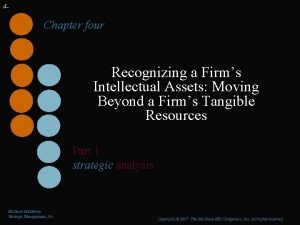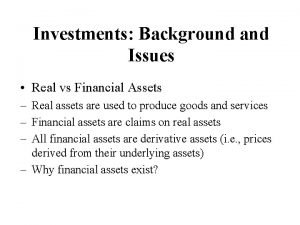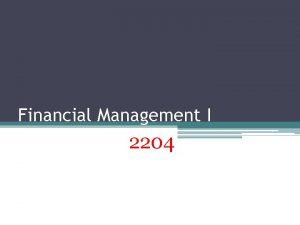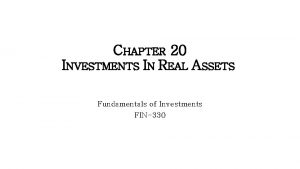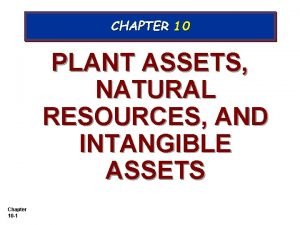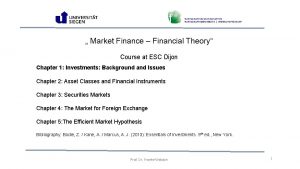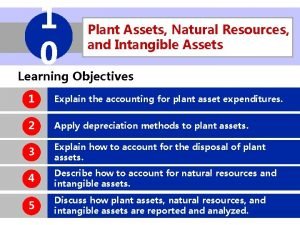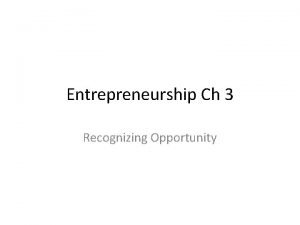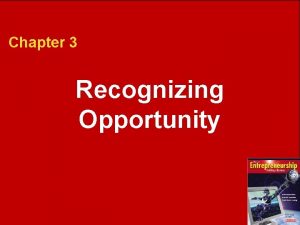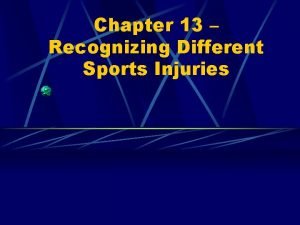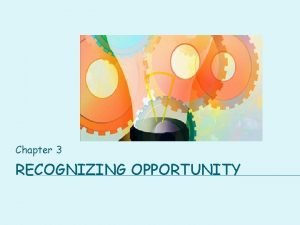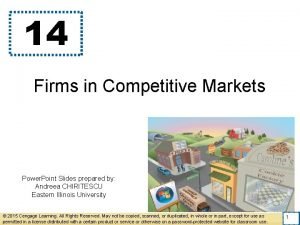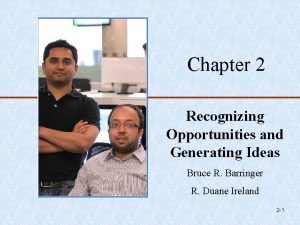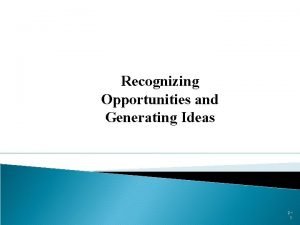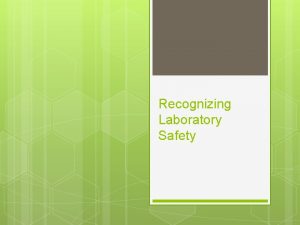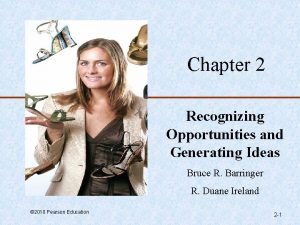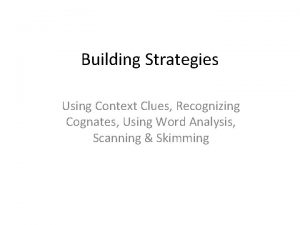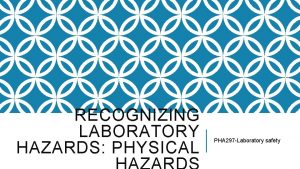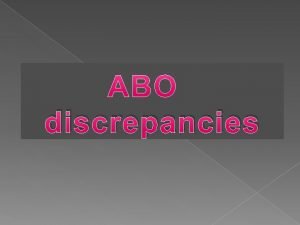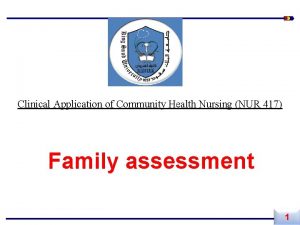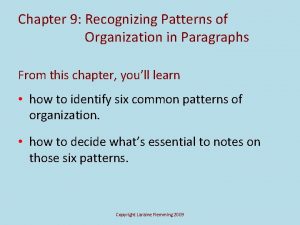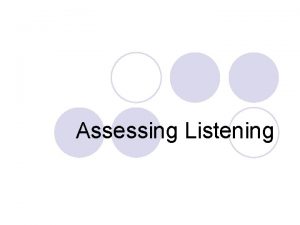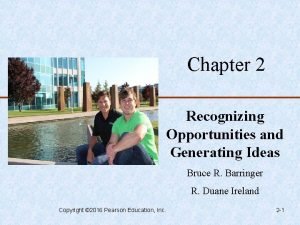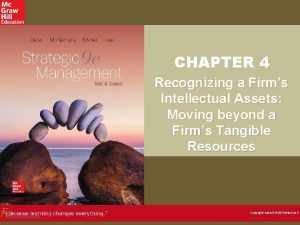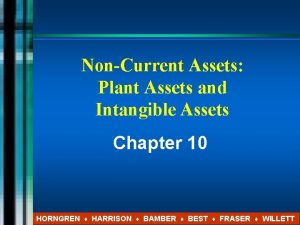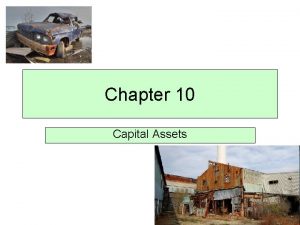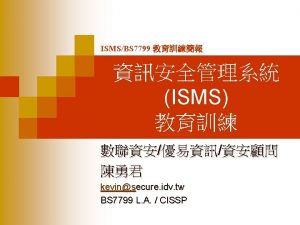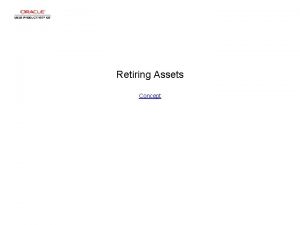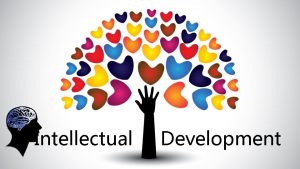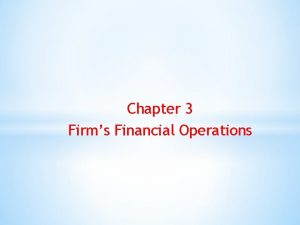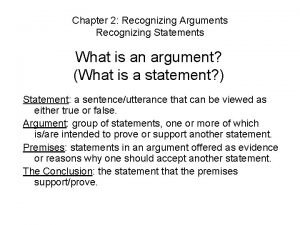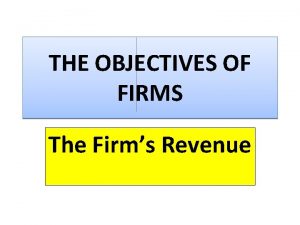4 Chapter four Recognizing a Firms Intellectual Assets



































- Slides: 35

4 - Chapter four Recognizing a Firm’s Intellectual Assets: Moving Beyond a Firm’s Tangible Resources Part 1: strategic analysis Mc. Graw-Hill/Irwin Strategic Management, 3/e Copyright © 2007 The Mc. Graw-Hill Companies, Inc. All rights reserved.

4 - Learning Objectives Ø Ø Ø Mc. Graw-Hill/Irwin Strategic Management, 3/e After reading this chapter, you should have a good understanding of: Why the management of knowledge professionals and knowledge itself are so critical in today’s organizations. The importance of recognizing the interdependence of attracting, developing and retaining human capital. Copyright © 2007 The Mc. Graw-Hill Companies, Inc. All rights reserved.

4 - Learning Objectives Ø Ø Mc. Graw-Hill/Irwin Strategic Management, 3/e After reading this chapter, you should have a good understanding of: The key role of social capital in leveraging human capital within and across the firm. Why teams are critical in combining and leveraging knowledge in organizations and how they can be made more effective. The vital role of technology in leveraging knowledge and human capital. Copyright © 2007 The Mc. Graw-Hill Companies, Inc. All rights reserved.

4 - Learning Objectives Ø Ø Ø Mc. Graw-Hill/Irwin Strategic Management, 3/e After reading this chapter, you should have a good understanding of: How technology can help to retain knowledge even when employees cannot be retained by the organization. How leveraging human capital is critical to strategy formulation at the business, corporate, international, and Internet levels. Copyright © 2007 The Mc. Graw-Hill Companies, Inc. All rights reserved.

4 - Ratio of Market Value to Book Value for Selected Companies Company Annual Market Book Ratio of Sales Value Market to ($ billions) Book Value Google 3. 2 60. 4 2. 9 20. 8 Genentech 3. 9 75. 0 6. 8 11. 0 Yahoo! 3. 6 47. 9 7. 1 6. 7 e. Bay 3. 2 42. 8 6. 7 6. 4 Southwest Airlines 6. 5 11. 7 5. 5 2. 1 Union Pacific (Railroad) 12. 2 16. 7 12. 7 1. 3 Ford Motor Company 171. 6 16. 7 16. 0 1. 0 Note: The data on market valuations are as of May 1, 2005. All other financial data is based on the most recently available balance sheets and income statements. Mc. Graw-Hill/Irwin Strategic Management, 3/e Exhibit 4. 1 Ratio of Market Value to Book Value for Selected Companies Copyright © 2007 The Mc. Graw-Hill Companies, Inc. All rights reserved.

4 - The Central Role of Knowledge in Today’s Economy Ø Creation of wealth in a knowledge economy Ø Ø Ø Ø Ø Mc. Graw-Hill/Irwin Strategic Management, 3/e Effective management of knowledge workers Intellectual capital Assets such as Reputation Employee loyalty and commitment Customer relationships Company values Brand names Experience and skills of employees Copyright © 2007 The Mc. Graw-Hill Companies, Inc. All rights reserved.

4 - The Central Role of Knowledge in Today’s Economy Intellectual capital = Market value of the firm – Book value of the firm How do companies create value in the knowledgeintensive economy? Ø Ø Ø Mc. Graw-Hill/Irwin Strategic Management, 3/e Human capital (individual capabilities, knowledge, skills, and experience of the company’s employees and managers) Social capital (the network of relationships that individuals have throughout the organization) Knowledge Explicit knowledge Tacit knowledge Copyright © 2007 The Mc. Graw-Hill Companies, Inc. All rights reserved.

4 - Human Capital: The Foundation of Intellectual Capital Mc. Graw-Hill/Irwin Strategic Management, 3/e Exhibit 4. 2 Human Capital: Three Interdependent Activities Copyright © 2007 The Mc. Graw-Hill Companies, Inc. All rights reserved.

4 - Attracting Human Capital ØHire for attitude, train for skill ØEmphasis on ØGeneral knowledge and experience ØSocial skills ØValues ØBeliefs ØAttitudes Mc. Graw-Hill/Irwin Strategic Management, 3/e Copyright © 2007 The Mc. Graw-Hill Companies, Inc. All rights reserved.

4 - Attracting Human Capital ØSound recruiting approaches ØScanning pools of available candidates ØChallenge becomes having the right job candidates, not the greatest number of them ØNetworking ØCurrent employees may be best source of new ones ØIncentives for referrals Mc. Graw-Hill/Irwin Strategic Management, 3/e Copyright © 2007 The Mc. Graw-Hill Companies, Inc. All rights reserved.

4 - Developing Human Capital ØTrain and develop at all levels ØTraining is not the sole responsibility of the human resource department ØRapid changes in technology ØEmployee skills become obsolete ØTraining is cost effective ØMonitor progress and track development Mc. Graw-Hill/Irwin Strategic Management, 3/e Copyright © 2007 The Mc. Graw-Hill Companies, Inc. All rights reserved.

4 - Developing Human Capital ØEvaluate human capital ØEmployees must share knowledge and work together, collectively, to reach organizational goals ØFirms often use 360 -degree evaluation and feedback systems ØManagers’ success cannot compromise the organization’s core values Mc. Graw-Hill/Irwin Strategic Management, 3/e Copyright © 2007 The Mc. Graw-Hill Companies, Inc. All rights reserved.

360 -Degree Leadership Assessment @ GE Performance Criteria of “Vision” 4 - Ø Has developed and communicated a clear, simple, customer-focused vision/direction for the organization. Ø Forward-thinking, stretches horizons, challenges imaginations. Ø Inspires and energizes others to commit to Vision. Captures minds. Leads by example. Ø As appropriate, updates Vision to reflect constant and accelerating change affecting the business Ten Characteristics of Leadership Vision Customer/Quality Focus Integrity Accountability/Commitment Communication/Influence Mc. Graw-Hill/Irwin Strategic Management, 3/e Shared Ownership/Boundary-less Team Builder/Empowerment Knowledge/Expertise/Intellect Initiative/Speed Global Mind-Set Adapted from Exhibit 4. 3 An Excerpt from General Electric’s 360 -Degree Leadership Assessment Chart Source: Adapted from R. Slater, Get Better or Get Beaten (Burr Ridge, IL: Irwin Professional Publishing, 1994), pp. 152 -155. Copyright © 2007 The Mc. Graw-Hill Companies, Inc. All rights reserved.

4 - Retaining Human Capital ØProvide mechanisms that prevent the transfer of valuable and sensitive information outside the organization ØIdentify with organization’s mission and values ØStrong alliance to organization (strategic intents) ØChallenging work and stimulating environment Mc. Graw-Hill/Irwin Strategic Management, 3/e Copyright © 2007 The Mc. Graw-Hill Companies, Inc. All rights reserved.

4 - Retaining Human Capital ØFinancial and Nonfinancial Rewards and Incentives ØRewards are a vital organizational control mechanism ØHowever, money may not be the most important reason why people take or leave jobs ØExodus of employees can erode a firm’s competitive advantage Mc. Graw-Hill/Irwin Strategic Management, 3/e Copyright © 2007 The Mc. Graw-Hill Companies, Inc. All rights reserved.

4 - Enhancing Human Capital: How Diversity Benefits the Organization 1. 2. 3. 4. 5. 6. Mc. Graw-Hill/Irwin Strategic Management, 3/e Cost argument Resource acquisition argument Marketing argument Creativity argument Problem-solving argument System flexibility argument Copyright © 2007 The Mc. Graw-Hill Companies, Inc. All rights reserved.

4 - The Vital Role of Social Capital ØAttraction, development and retention of talent is a necessary but not sufficient condition for creating competitive advantage ØKnowledge workers often are more loyal to their colleagues and profession than to their employer Mc. Graw-Hill/Irwin Strategic Management, 3/e Copyright © 2007 The Mc. Graw-Hill Companies, Inc. All rights reserved.

4 - How Social Capital Helps Attract and Retain Talent ØHiring via personal (social) networks ØSome job candidates may bring other talent with them ØEmigration of talent from an organization to form start-up ventures ØCan provide mechanism for obtaining resources and information from outside the organization Mc. Graw-Hill/Irwin Strategic Management, 3/e Copyright © 2007 The Mc. Graw-Hill Companies, Inc. All rights reserved.

4 - Microsoft Employees Who Have Left the Company for Other Businesses Company What It Does Defectors from Microsoft Crossgain Builds software around XMl computer language 23 of 60 employees Vi. Air Makes software for wireless providers Company declines to specify Check. Space Builds online payment service for small businesses Company says “a good chunk” of its 30 employees digi. Mine Sells data mining service About 15% of 62 employees in addition to the 3 founders Avogadro Builds wireless notification software 8 of 25 employees Tellme Networks Offers information like stock quotes and scores over the phone About 40 of 250 employees; another 40 from the former Netscape Mc. Graw-Hill/Irwin Strategic Management, 3/e Exhibit 4. 4 Microsoft Employees Who Have Left the Company for Other Businesses Source: Reprinted by permission of the Wall Street Journal, Copyright © 2000 Dow Jones & Company, Inc. All Rights Reserved Worldwide. License number 397221136576. Copyright © 2007 The Mc. Graw-Hill Companies, Inc. All rights reserved.

4 - Social Networks: Implications for KM ØMove away from top-down bureaucratic control to open, decentralized network models of org. ØSocial network analysis; ØAnalysis of the pattern of social interactions among individuals ØClosure ØBridging Mc. Graw-Hill/Irwin Strategic Management, 3/e Copyright © 2007 The Mc. Graw-Hill Companies, Inc. All rights reserved.

4 - Social Networks: Implications for KM ØClosure ØGroup has a higher level of connectedness ØHigh levels of trust ØExtend favors (reciprocity) ØEmotional support Ø(-) Cut themselves from the rest of the organization. Mc. Graw-Hill/Irwin Strategic Management, 3/e Copyright © 2007 The Mc. Graw-Hill Companies, Inc. All rights reserved.

4 - Social Networks: Implications for KM ØBridging relationships ØRelationship in a social network that connect otherwise disconnected people ØUseful to fill “Structural holes” ØGood for timely resources from different functions Mc. Graw-Hill/Irwin Strategic Management, 3/e Copyright © 2007 The Mc. Graw-Hill Companies, Inc. All rights reserved.

4 - The Potential Downside of Social Capital ØGroupthink ØCost of financial resources (orientation & training) ØManagerial commitment Mc. Graw-Hill/Irwin Strategic Management, 3/e Copyright © 2007 The Mc. Graw-Hill Companies, Inc. All rights reserved.

4 - Using Technology to Leverage Human Capital and Knowledge ØSharing knowledge and information ØConserves resources ØDevelops products and services ØCreates new opportunities ØTechnology can leverage human capital and knowledge ØWithin the organization ØWith customers ØWith suppliers Mc. Graw-Hill/Irwin Strategic Management, 3/e Copyright © 2007 The Mc. Graw-Hill Companies, Inc. All rights reserved.

4 - Using Technology to Leverage Human Capital and Knowledge Using Networks Using networks to share information and develop products and services ØE-mail ØElectronic or Virtual teams ØEnhance speed and effectiveness with which products are developed ØCan be applied to new business ventures Mc. Graw-Hill/Irwin Strategic Management, 3/e Copyright © 2007 The Mc. Graw-Hill Companies, Inc. All rights reserved.

4 - Using Technology to Leverage Human Capital and Knowledge Using Networks Codifying Knowledge Codifying knowledge for competitive advantage ØTacit knowledge ØPersonal experience ØShared only with the consent and participation of the individual ØExplicit (codified) knowledge Mc. Graw-Hill/Irwin Strategic Management, 3/e ØCan be documented ØCan be widely distributed ØCan be easily replicated ØCan be reused many times at low cost Copyright © 2007 The Mc. Graw-Hill Companies, Inc. All rights reserved.

4 - Using Technology to Leverage Human Capital and Knowledge Using Networks Codifying Knowledge Retaining Knowledge Mc. Graw-Hill/Irwin Strategic Management, 3/e Retaining knowledge when employees leave ØInformation technology can save some tacit knowledge ØNeed to create motivation for people to contribute their knowledge to the system Copyright © 2007 The Mc. Graw-Hill Companies, Inc. All rights reserved.

4 - Issues to consider in: Creating Value Through Human Capital, Social Capital, and Technology Human Capital Recruiting “Top-Notch” Human Capital ØDoes the organization assess attitude and “general make-up” instead of focusing primarily on skills and background in selecting employees at all levels? ØHow important is creativity and problem solving ability? Are they properly considered in hiring decisions? ØDo people throughout the organization engage in effective networking activities to obtain a broad pool of worthy potential employees? Is the organization creative in such endeavors? Mc. Graw-Hill/Irwin Strategic Management, 3/e Adapted from Exhibit 4. 5 Issues to Consider in Creating Value through Human Capital, Social Capital, and Technology Source: Adapted from G. G. Dess and J. C. Picken, Beyond Productivity (New York: AMACON, 1999), pp. 63 -64. Copyright © 2007 The Mc. Graw-Hill Companies, Inc. All rights reserved.

4 - Creating Value Through Human Capital, Social Capital, and Technology Human Capital Enhancing Human Capital through Employee Development Ø Does the development and training process inculcate an “organizationwide” perspective? Ø Is there widespread involvement—including top executives—in the preparation and delivery of training and development programs? Ø Is the development of human capital effectively tracked and monitored? Ø Are there effective programs for succession at all levels of the organization—especially the top-most levels? Ø Does the firm effectively evaluate its human capital? Is a 360 -degree evaluation used? Why not? Ø Are mechanisms in place to assure that a manager’s success does not come at the cost of compromising the organization’s core values? Mc. Graw-Hill/Irwin Strategic Management, 3/e Adapted from Exhibit 4. 5 Issues to Consider in Creating Value through Human Capital, Social Capital, and Technology Source: Adapted from G. G. Dess and J. C. Picken, Beyond Productivity (New York: AMACON, 1999), pp. 63 -64. Copyright © 2007 The Mc. Graw-Hill Companies, Inc. All rights reserved.

4 - Creating Value Through Human Capital, Social Capital, and Technology Human Capital Retaining the Best Employees Ø Are there appropriate financial rewards to motivate employees at all levels? Ø Do people throughout the organization strongly identify with the organization’s mission? Ø Are employees provided a stimulating and challenging work environment that fosters professional growth? Ø Are valued amenities provided (e. g. , flextime, child-care facilities, telecommuting) that are appropriate given the organization’s mission, strategy, and how work is accomplished? Ø Is the organization continually devising strategies and mechanisms to retain top performers? Mc. Graw-Hill/Irwin Strategic Management, 3/e Adapted from Exhibit 4. 5 Issues to Consider in Creating Value through Human Capital, Social Capital, and Technology Source: Adapted from G. G. Dess and J. C. Picken, Beyond Productivity (New York: AMACON, 1999), pp. 63 -64. Copyright © 2007 The Mc. Graw-Hill Companies, Inc. All rights reserved.

4 - Creating Value Through Human Capital, Social Capital, and Technology Social Capital ØAre there positive personal and professional relationships among employees? ØIs the organization benefiting (or being penalized) by hiring (or by voluntary turnover) en masse? ØDoes an environment of caring and encouragement rather than competition enhance team performance? ØDoes the organization minimize the adverse effects of excessive social capital—such as excessive costs and “groupthink”? Mc. Graw-Hill/Irwin Strategic Management, 3/e Adapted from Exhibit 4. 5 Issues to Consider in Creating Value through Human Capital, Social Capital, and Technology Source: Adapted from G. G. Dess and J. C. Picken, Beyond Productivity (New York: AMACON, 1999), pp. 63 -64. Copyright © 2007 The Mc. Graw-Hill Companies, Inc. All rights reserved.

4 - Creating Value Through Human Capital, Social Capital, and Technology ØDoes the organization effectively use technology to transfer best practices across the organization? ØDoes the organization use technology to leverage both human capital and knowledge both within the boundaries of the organization as well as among its suppliers and customers? ØHas the organization used technologies such as e-mail and networks to develop products and services? ØHas the organization effectively used technology to codify knowledge for competitive advantage? ØDoes the organization try to retain some of the knowledge of employees when they decide to leave the firm? Mc. Graw-Hill/Irwin Strategic Management, 3/e Adapted from Exhibit 4. 5 Issues to Consider in Creating Value through Human Capital, Social Capital, and Technology Source: Adapted from G. G. Dess and J. C. Picken, Beyond Productivity (New York: AMACON, 1999), pp. 63 -64. Copyright © 2007 The Mc. Graw-Hill Companies, Inc. All rights reserved.

4 - The Central Role of Leveraging Human Capital in Strategy Formulation ØLeveraging human capital and business-level strategy (Chapter 5) ØSustainable over time ØIntegrate primary and support activities in the firm’s value chain ØLeveraging human capital and corporate-level strategy (Chapter 6) ØManage businesses to create synergy ØCreate more value by working together across business units Mc. Graw-Hill/Irwin Strategic Management, 3/e Copyright © 2007 The Mc. Graw-Hill Companies, Inc. All rights reserved.

4 - The Central Role of Leveraging Human Capital in Strategy Formulation ØLeveraging human capital and international-level strategy (Chapter 7) ØAchieve economies of scale ØAdapt to local market needs ØFacilitate the flow of information and knowledge between business units in different countries Mc. Graw-Hill/Irwin Strategic Management, 3/e Copyright © 2007 The Mc. Graw-Hill Companies, Inc. All rights reserved.

4 - The Central Role of Leveraging Human Capital in Strategy Formulation ØLeveraging human capital and internet strategies (Chapter 8) ØCreate competitive advantages through digital and Internet-based technologies ØLower costs ØEnhance customer service ØImprove performance Mc. Graw-Hill/Irwin Strategic Management, 3/e Copyright © 2007 The Mc. Graw-Hill Companies, Inc. All rights reserved.
 Recognizing a firm's intellectual assets
Recognizing a firm's intellectual assets Real assets vs financial assets
Real assets vs financial assets Real assets vs financial assets
Real assets vs financial assets Real assets and financial assets ppt
Real assets and financial assets ppt Plant assets natural resources and intangible assets中文
Plant assets natural resources and intangible assets中文 Accumulated depreciation straight line method
Accumulated depreciation straight line method Financial assets examples
Financial assets examples Plant assets, natural resources, and intangible assets
Plant assets, natural resources, and intangible assets Chapter 3 recognizing opportunity
Chapter 3 recognizing opportunity Chapter 3 recognizing opportunity
Chapter 3 recognizing opportunity Chapter 13 worksheet recognizing different sports injuries
Chapter 13 worksheet recognizing different sports injuries Chapter 3 recognizing opportunity
Chapter 3 recognizing opportunity Chapter 3 recognizing opportunity
Chapter 3 recognizing opportunity Firms in competitive markets chapter 14 ppt
Firms in competitive markets chapter 14 ppt Harmful and useful materials at home
Harmful and useful materials at home Listening for specific details top down or bottom up
Listening for specific details top down or bottom up Recognizing opportunities and generating ideas
Recognizing opportunities and generating ideas Argumentative text anchor chart
Argumentative text anchor chart Channel design meaning
Channel design meaning Recognizing opportunities
Recognizing opportunities Recognizing lab safety worksheet answers
Recognizing lab safety worksheet answers An opportunity has four essential qualities it is
An opportunity has four essential qualities it is Strategy: recognizing cognates
Strategy: recognizing cognates An argumentative essay is a genre of writing that
An argumentative essay is a genre of writing that Recognizing laboratory safety
Recognizing laboratory safety I have always enjoyed reading the book more than
I have always enjoyed reading the book more than Personal pronouns
Personal pronouns Recognizing and resolving abo discrepancies
Recognizing and resolving abo discrepancies Recognizing interruptions of health development
Recognizing interruptions of health development Listing pattern of organization
Listing pattern of organization The importance of listening in lang
The importance of listening in lang The hot july sun beat relentlessly down
The hot july sun beat relentlessly down Channel design decisions with examples
Channel design decisions with examples Happy ka adverb kya hoga
Happy ka adverb kya hoga Recognizing opportunities and generating ideas
Recognizing opportunities and generating ideas Chapter 9 intellectual development in the first year
Chapter 9 intellectual development in the first year
